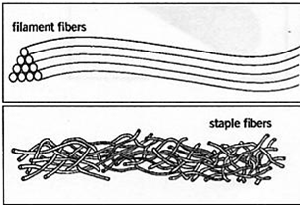If you want to choose the best bed sheets, you have to know what to look for. But what if you’re not sure what all the different terms mean? Don’t worry, we have this covered with our glossary of the most important bedding related terms you’ll need.

Cotton

This fiber grows as a boll around the cotton seeds and has a length of 0.5 to 2 inches. It consists of 90% cellulose, 6% moisture, the remaining part is fat and impurities. A wax-like protective coating cover’s the cotton boll’s outer surface. It is the most commonly used natural fiber, which is not surprising considering its characteristics. Products made from cotton are usually strong, soft, and have good heat conductivity.
Egyptian cotton is a high quality cotton type. The quality comes from the extra-long fibers that allow for a smoother, stronger, and softer fabric. Contrary to its name, Egyptian cotton is not only grown in Egypt, although that’s where this cotton type originally comes from.
Like Egyptian cotton, true Pima cotton is quite the luxury. Pima cotton is also extra-long staple cotton and is grown in Peru, some parts of the US and Australia.
Supima cotton is exclusively US-grown Pima cotton. It’s a licensed trademark, with only a select few members being able to say that their products are made from this high quality cotton.
Fabric
Fabric is a material that consists of a network of yarns or threads. It is intended for further production of goods, such as garments. It is often used as a synonym of cloth. There are slight differences between the terms however. A cloth is usually a piece of processed fabric.
When searching for bed sheets, you will most likely come across fabrics like cotton, flannel (a specific type of cotton), silk, linen, bamboo.
Fiber
In the world of bedding, fiber is a substance that is much longer than it is wide. On its own, it can’t be used for much but it’s where it all starts from. In the bedding scene we refer to these as textile fibers, which can be of a natural or synthetic source. Fibers are spun together to create yarns.
Natural fibers can be animal-based or plant-based and are found in nature. Some common animal-based fibers are wool (from sheep), cashmere wool (from Indian cashmere goat), and silk (from silkworms). Well-known plant-based fibers are cotton, bamboo, and flax.
Contrary to natural fibers, synthetic fibers are man-made, as a result of chemical synthesis. When it comes to bedding, the most well-known synthetic fibers are microfiber and polyester. Other synthetic fibers used in the textile industry are nylon and spandex.
Filament

A filament is a continuous fiber. You can think of it as an infinite fiber, such as the silk from a silkworm. Silk is actually one of the very few natural fibers that is a filament. Other filaments are man-made, for example polyester and nylon.
Staple and staple length
Staple is a fiber of discrete length, as opposed to filament. In other words, it is a small length fiber. These include natural fibers, such as cotton and wool, as well as man-made fibers. Natural fibers vary in length, so the staple also varies. Man-made fibers are cut to the same exact length, so there the staple stays the same.
Cotton fibers are roughly classified into 4 staple groups:
- short: length is under 1 in (2.54 cm)
- medium: length is 1-1.125 in (2.54-2.85 cm)
- long: length is 1.125-1.4 in (2.85-3.56 cm)
- extra long: over 1.4 in (3.56 cm)
Longer staples have better quality because fewer fiber ends actually reach the surface. The result is a smoother, softer fabric that does not pill.
Thread

A textile thread is a specific type of yarn, intended for sewing. Threads and yarns are sometimes used as synonyms, although a thread can also consist of multiple yarns plied together.
While the verb we use for creating yarns from fibers is spinning, notice that the verb for creating threads from yarns is plying. The difference is actually pretty simple. Fibers are spun together in one direction to create a yarn, and the yarn is then plied together in the opposite direction, to create a stronger thread. The direction of the twists is different, symbolized as the letter S or Z.
Thread Count
A fabric’s thread count is a measurement unit that counts the number of threads per 1 square inch. This includes both the length and width threads.
Warp and Weft

Warp – lengthwise or longitudinal thread of a fabric. Warps are stretched on a frame of loom, under high tension, where they stay put during the following weave process.
Weft – widthwise or horizontal threads of a fabric. They are placed over and under warps that have been placed on a frame or loom in a stationary position.
Thread count is not always the right indicator to judge a sheet’s quality, contrary to what you may hear. Just as there are high thread count sheets of excellent quality, there are those that are best left forgotten.
Weave
This is the way the warp and weave threads interlace. We usually distinguish between 3 types of weaves: plain, satin, and twill. If you come across other terms, like houndstooth, birdseye, are different designs or secondary weaves.

The most common type of weave is a plain weave, where the weft thread goes over one warp, then under the next warp, then over the next warp etc. This forms a criss-cross pattern. Another well-known weave is satin, in which case the surface of the fabric consists predominantly of warps. The weft typically passes under 4 warps, then over 1 warp, then under 4 warps, etc. The third type of weave is twill, that has a diagonal appearance.